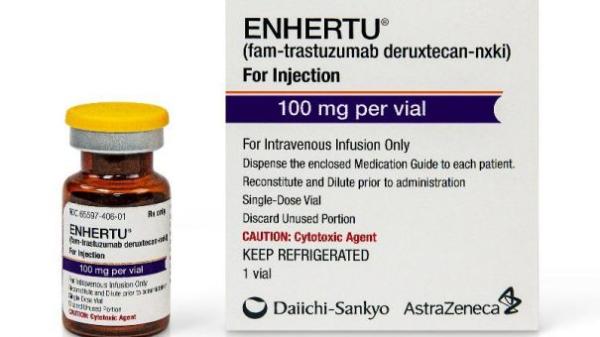Enhertu Dosage
Generic name: TRASTUZUMAB DERUXTECAN 100mg in 5mL
Dosage form: injection, powder, lyophilized, for solution
Drug class: HER2 inhibitors
Medically reviewed by Drugs.com. Last updated on Jul 10, 2025.
Patient Selection
HER2-Low or HER2-Ultralow Unresectable or Metastatic Breast Cancer
Select patients for treatment of unresectable or metastatic HER2-low (IHC 1+ or IHC 2+/ISH-) or HER2-ultralow (IHC 0 with membrane staining) breast cancer with ENHERTU based on HER2 expression.
HER2-Mutant Unresectable or Metastatic NSCLC
Select patients for the treatment of unresectable or metastatic HER2-mutant NSCLC with ENHERTU based on the presence of activating HER2 (ERBB2) mutations in tumor or plasma specimens. If no mutation is detected in a plasma specimen, test tumor tissue.
HER2-Positive Locally Advanced or Metastatic Gastric Cancer
Select patients with locally advanced or metastatic HER2-positive gastric cancer based on HER2 protein overexpression or HER2 gene amplification (IHC 3+ or IHC 2+/ISH positive). Reassess HER2 status if it is feasible to obtain a new tumor specimen after prior trastuzumab-based therapy and before treatment with ENHERTU.
HER2-Positive (IHC 3+) Unresectable or Metastatic Solid Tumors
Select patients for treatment of unresectable or metastatic solid tumors with ENHERTU based on HER2-positive (IHC 3+) specimens. An FDA-approved test for the detection of HER2-positive (IHC 3+) solid tumors for treatment with ENHERTU is not currently available.
Recommended Dosage and Schedules
Do not substitute ENHERTU for or with trastuzumab or ado-trastuzumab emtansine.
Slow or interrupt the infusion rate if the patient develops infusion-related symptoms.
Permanently discontinue ENHERTU in case of severe infusion reactions.
Premedication
ENHERTU is highly emetogenic, which includes delayed nausea and/or vomiting. Administer prophylactic antiemetic medications per local institutional guidelines for prevention of chemotherapy-induced nausea and vomiting.
Recommended Dosage for HER2-Positive, HER2-Low, or HER2-Ultralow Metastatic Breast Cancer, HER2-Mutant Unresectable or Metastatic NSCLC, and HER2-Positive (IHC 3+) Unresectable or Metastatic Solid Tumors.
The recommended dosage of ENHERTU is 5.4 mg/kg given as an intravenous infusion once every 3 weeks (21-day cycle) until disease progression or unacceptable toxicity.
Dosage Modifications
Management of adverse reactions may require temporary interruption, dose reduction, or treatment discontinuation of ENHERTU as described in Tables 1 and 2.
Do not re-escalate the ENHERTU dose after a dose reduction is made.
If a planned dose is delayed or missed, administer as soon as possible; do not wait until the next planned cycle. Adjust the schedule of administration to maintain a 3-week interval between doses. Administer the infusion at the dose and rate the patient tolerated in the most recent infusion.
| Dose Reduction Schedule | Breast Cancer, NSCLC, and IHC 3+ Solid Tumors | Gastric Cancer |
|---|---|---|
| Recommended starting dose | 5.4 mg/kg | 6.4 mg/kg |
| First dose reduction | 4.4 mg/kg | 5.4 mg/kg |
| Second dose reduction | 3.2 mg/kg | 4.4 mg/kg |
| Requirement for further dose reduction | Discontinue treatment. | Discontinue treatment. |
| Adverse Reaction | Severity | Treatment Modification | |
|---|---|---|---|
| Toxicity grades are in accordance with National Cancer Institute Common Terminology Criteria for Adverse Events Version 5.0 (NCI CTCAE v.5.0). | |||
| Interstitial Lung Disease (ILD)/ Pneumonitis |
Asymptomatic ILD/pneumonitis (Grade 1) |
Interrupt ENHERTU until resolved to Grade 0, then:
|
|
| Symptomatic ILD/pneumonitis (Grade 2 or greater) |
|
||
| Neutropenia |
Grade 3 (less than 1.0 to 0.5 × 109/L) |
|
|
| Grade 4 (less than 0.5 × 109/L) |
|
||
| Febrile Neutropenia |
Absolute neutrophil count of less than 1.0 × 109/L and temperature greater than 38.3°C or a sustained temperature of 38°C or greater for more than one hour |
|
|
| Thrombocytopenia |
Grade 3 (platelets less than 50 to 25 × 109/L) |
|
|
| Grade 4 (platelets less than 25 × 109/L) |
|
||
| Left Ventricular Dysfunction |
LVEF greater than 45% and absolute decrease from baseline is 10% to 20% |
|
|
| LVEF 40% to 45% | And absolute decrease from baseline is less than 10% |
|
|
| And absolute decrease from baseline is 10% to 20% |
|
||
| LVEF less than 40% or absolute decrease from baseline is greater than 20% |
|
||
| Symptomatic congestive heart failure (CHF) |
|
||
Preparation and Administration
In order to prevent medication errors, check the vial labels to ensure that the drug being prepared and administered is ENHERTU (fam-trastuzumab deruxtecan-nxki) and not trastuzumab or ado-trastuzumab emtansine.
Reconstitute and further dilute ENHERTU prior to intravenous infusion. Use appropriate aseptic technique.
ENHERTU (fam-trastuzumab deruxtecan-nxki) is a hazardous drug. Follow applicable special handling and disposal procedures.1
Reconstitution
- Reconstitute immediately before dilution.
- More than one vial may be needed for a full dose. Calculate the dose (mg), the total volume of reconstituted ENHERTU solution required, and the number of vial(s) of ENHERTU needed.
- Reconstitute each 100 mg vial by using a sterile syringe to slowly inject 5 mL of Sterile Water for Injection, USP into each vial to obtain a final concentration of 20 mg/mL.
- Swirl the vial gently until completely dissolved. Do not shake.
- If not used immediately, store the reconstituted ENHERTU vials in a refrigerator at 2ºC to 8ºC (36ºF to 46ºF) for up to 24 hours from the time of reconstitution, protect the vial from light. Do not freeze.
- The product does not contain a preservative. Discard unused ENHERTU after 24 hours refrigerated.
Dilution
- Withdraw the calculated amount from the vial(s) using a sterile syringe. Parenteral drug products should be inspected visually for particulate matter and discoloration prior to administration whenever solution and container permit. The solution should be clear and colorless to light yellow. Do not use if visible particles are observed or if the solution is cloudy or discolored.
- Dilute the calculated volume of reconstituted ENHERTU in an intravenous infusion bag containing 100 mL of 5% Dextrose Injection, USP. DO NOT use Sodium Chloride Injection, USP. ENHERTU is compatible with an infusion bag made of polyvinylchloride or polyolefin (copolymer of ethylene and polypropylene).
- Gently invert the infusion bag to thoroughly mix the solution. Do not shake.
- Cover the infusion bag to protect from light.
- Discard any unused portion left in the vials.
Administration
- If not used immediately, store the diluted ENHERTU in a refrigerator at 2ºC to 8ºC (36ºF to 46ºF) for up to 24 hours or at room temperature between 20ºC to 25ºC (68ºF to 77 ºF) for up to 4 hours including preparation and infusion time.
- Protect from light. Do not freeze.
- The maximum time from reconstitution of the vial through the end of administration should not exceed 24 hours.
- If the prepared infusion solution was stored refrigerated (2ºC to 8ºC [36ºF to 46ºF]), allow the solution to reach room temperature prior to administration. Cover the infusion bag to protect from light.
- Administer ENHERTU as an intravenous infusion only with an infusion set made of polyolefin or polybutadiene.
- Administer ENHERTU with a 0.20 or 0.22 micron in-line polyethersulfone (PES) or polysulfone (PS) filter.
- Do NOT administer as an intravenous push or bolus.
- Cover the infusion bag to protect from light during administration.
- Do not mix ENHERTU with other drugs or administer other drugs through the same intravenous line.
- First infusion: Administer infusion over 90 minutes.
- Subsequent infusions: Administer over 30 minutes if prior infusions were well tolerated.
Frequently asked questions
- How well does Enhertu work in metastatic breast cancer?
- Is Enhertu a chemotherapy drug? What's Enhertu used for?
More about Enhertu (fam-trastuzumab deruxtecan)
- Check interactions
- Compare alternatives
- Pricing & coupons
- Reviews (36)
- Drug images
- Side effects
- During pregnancy
- FDA approval history
- Drug class: HER2 inhibitors
- En español
Patient resources
Professional resources
Related treatment guides
See also:
Further information
Always consult your healthcare provider to ensure the information displayed on this page applies to your personal circumstances.


